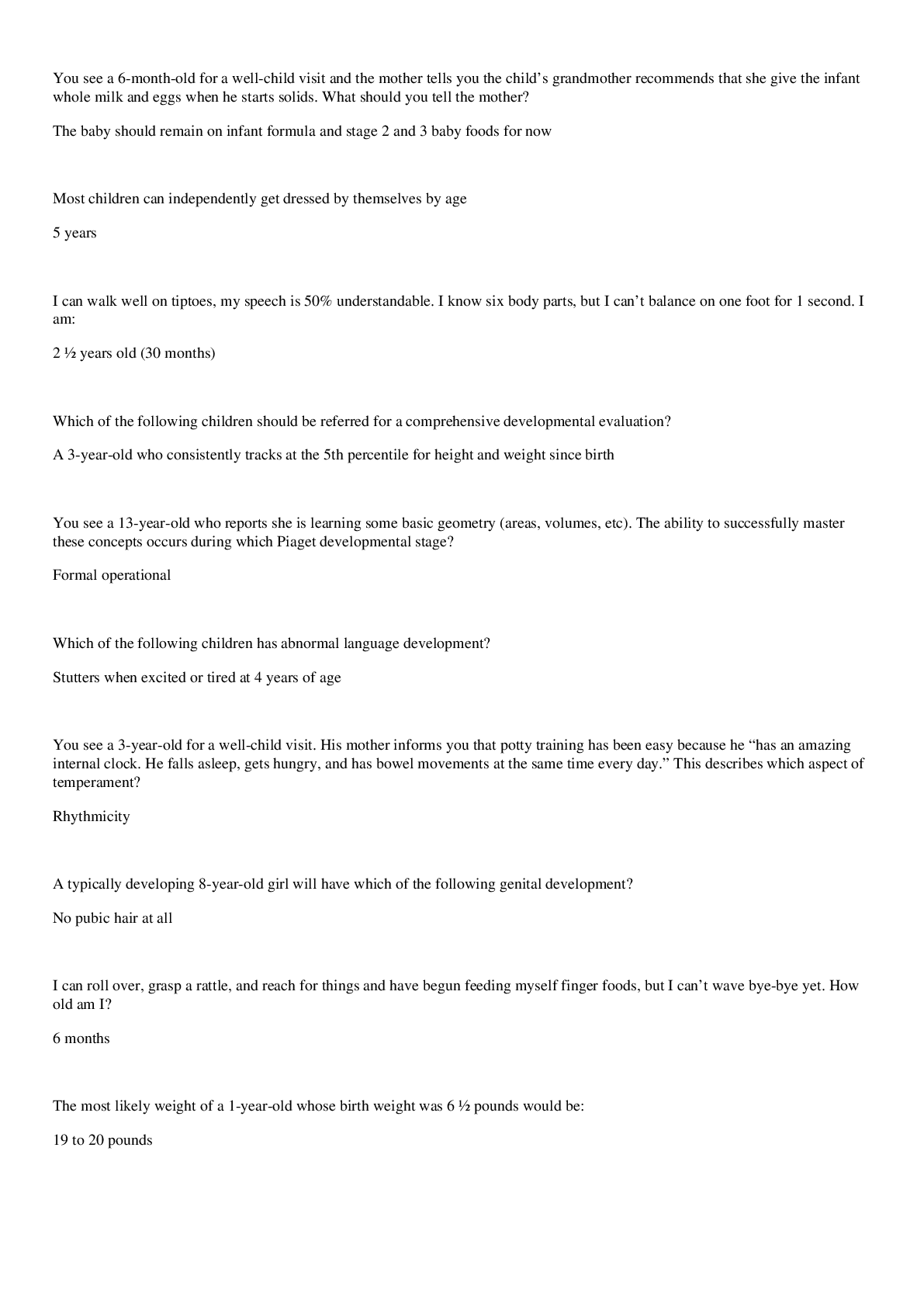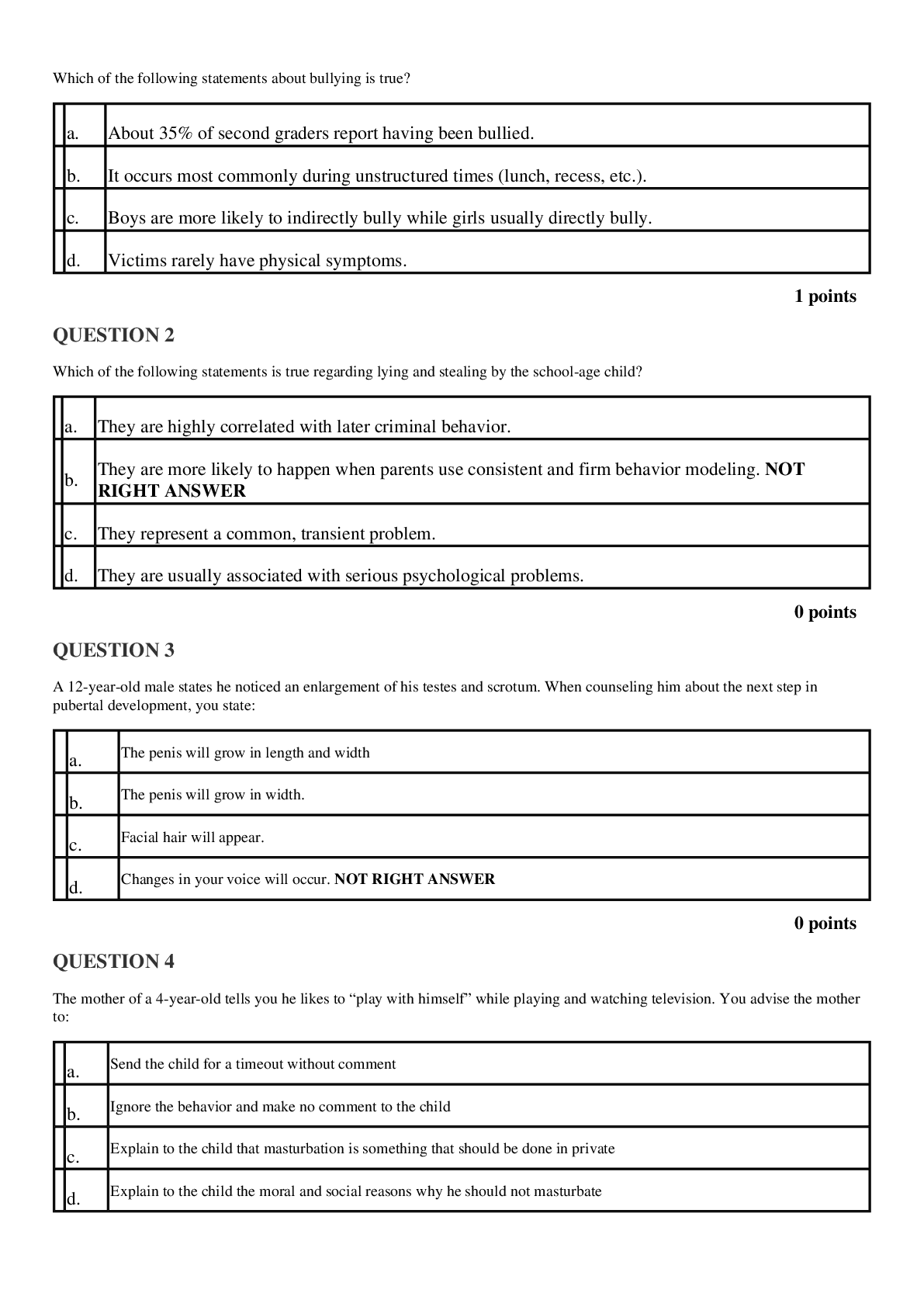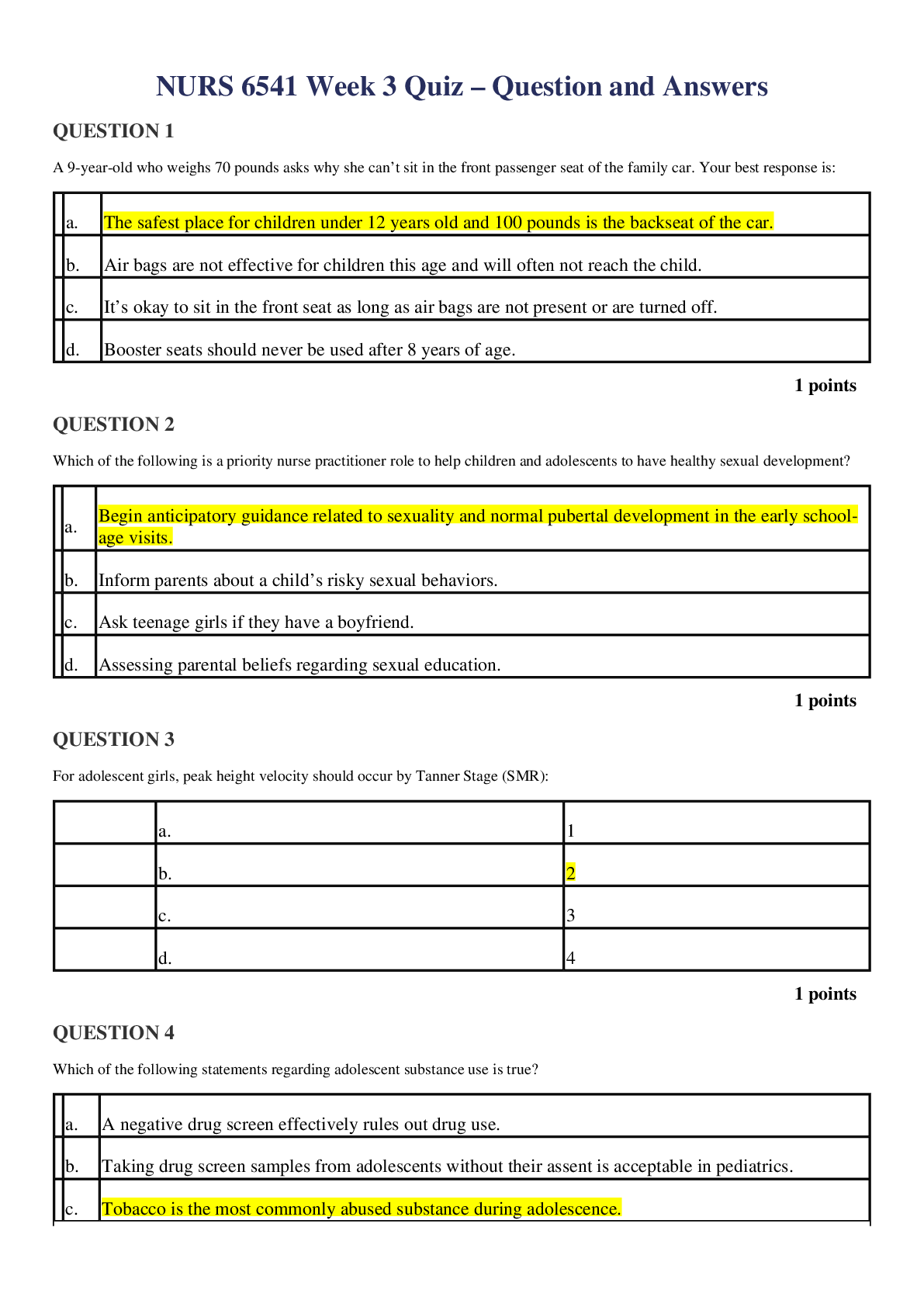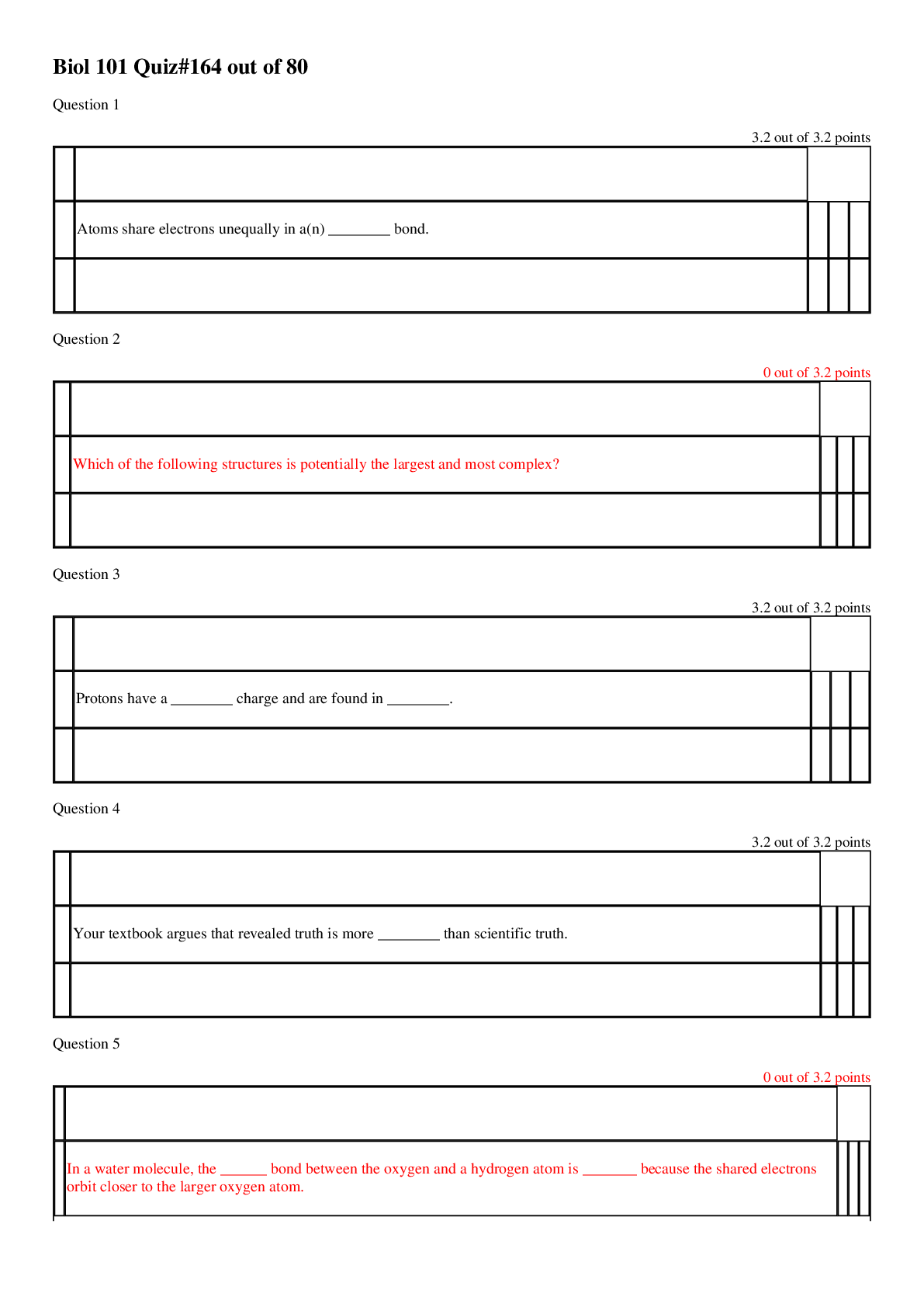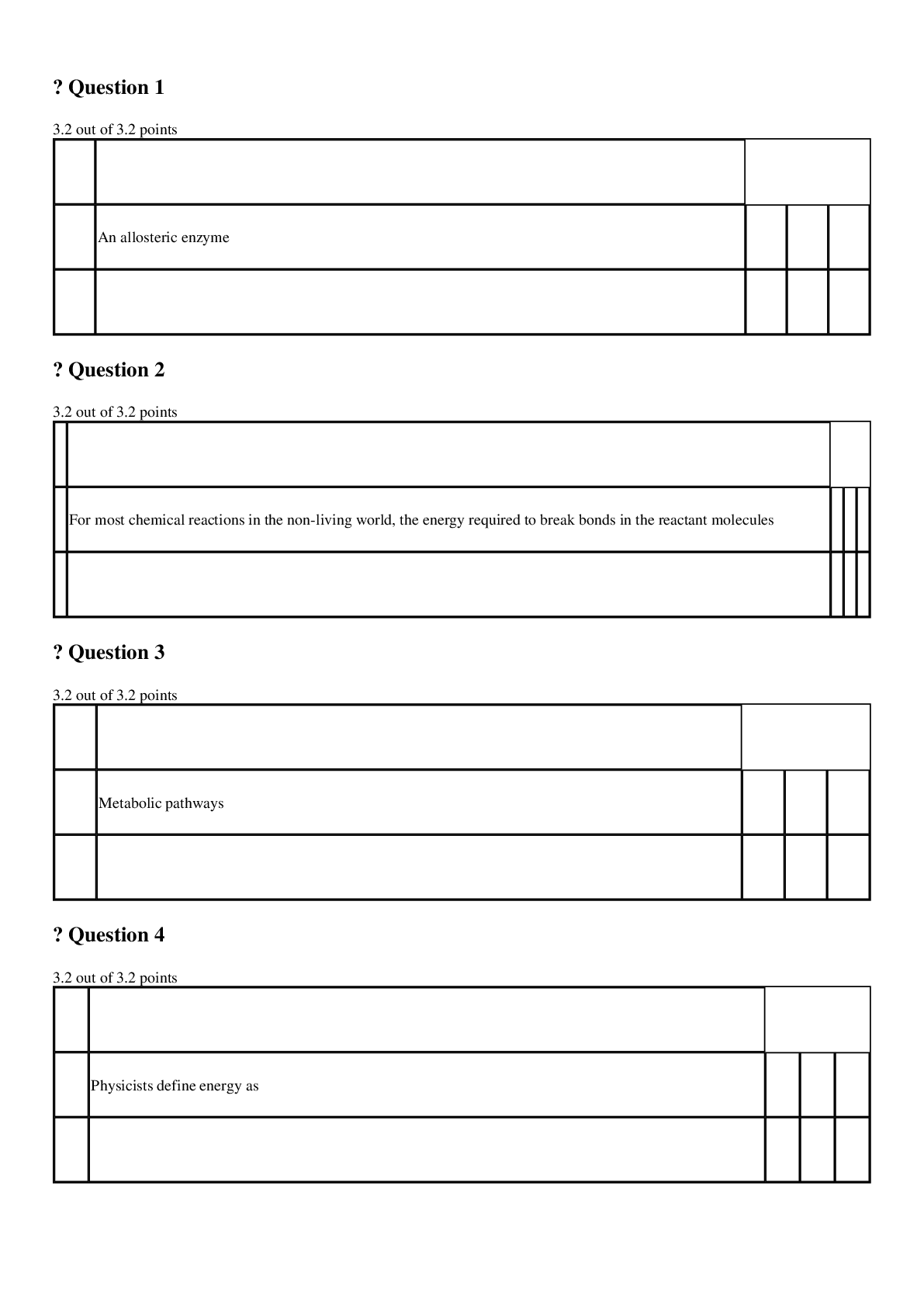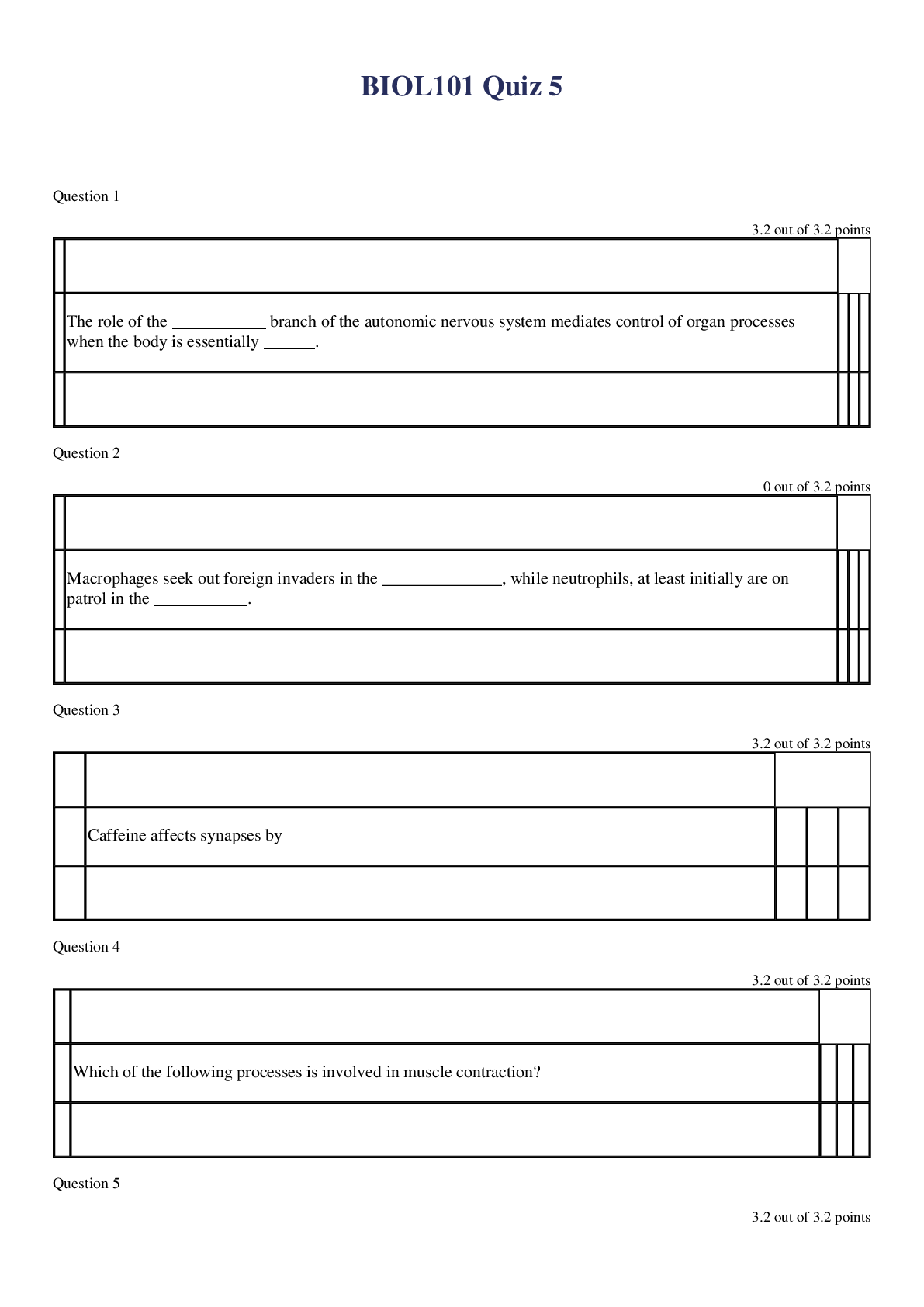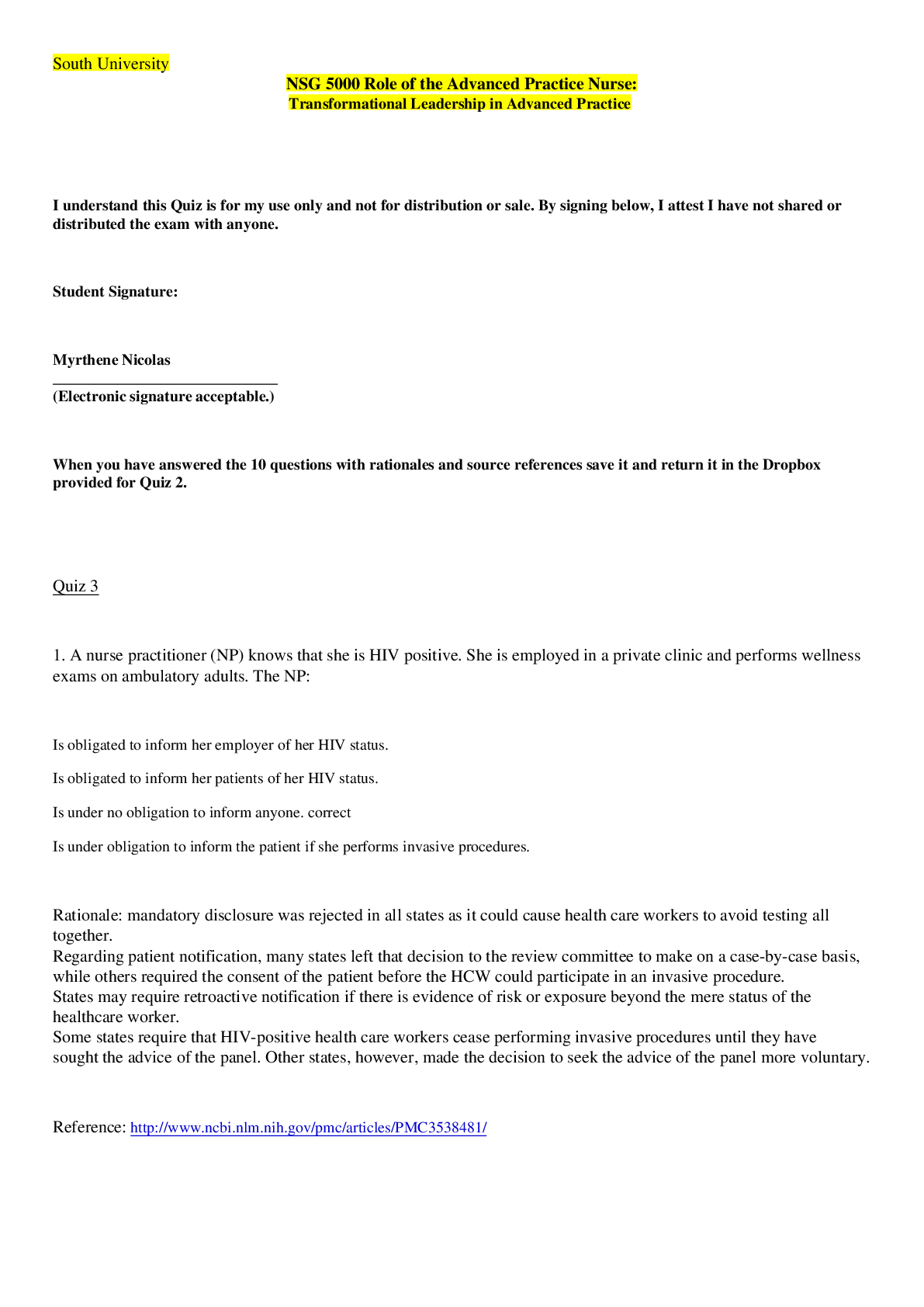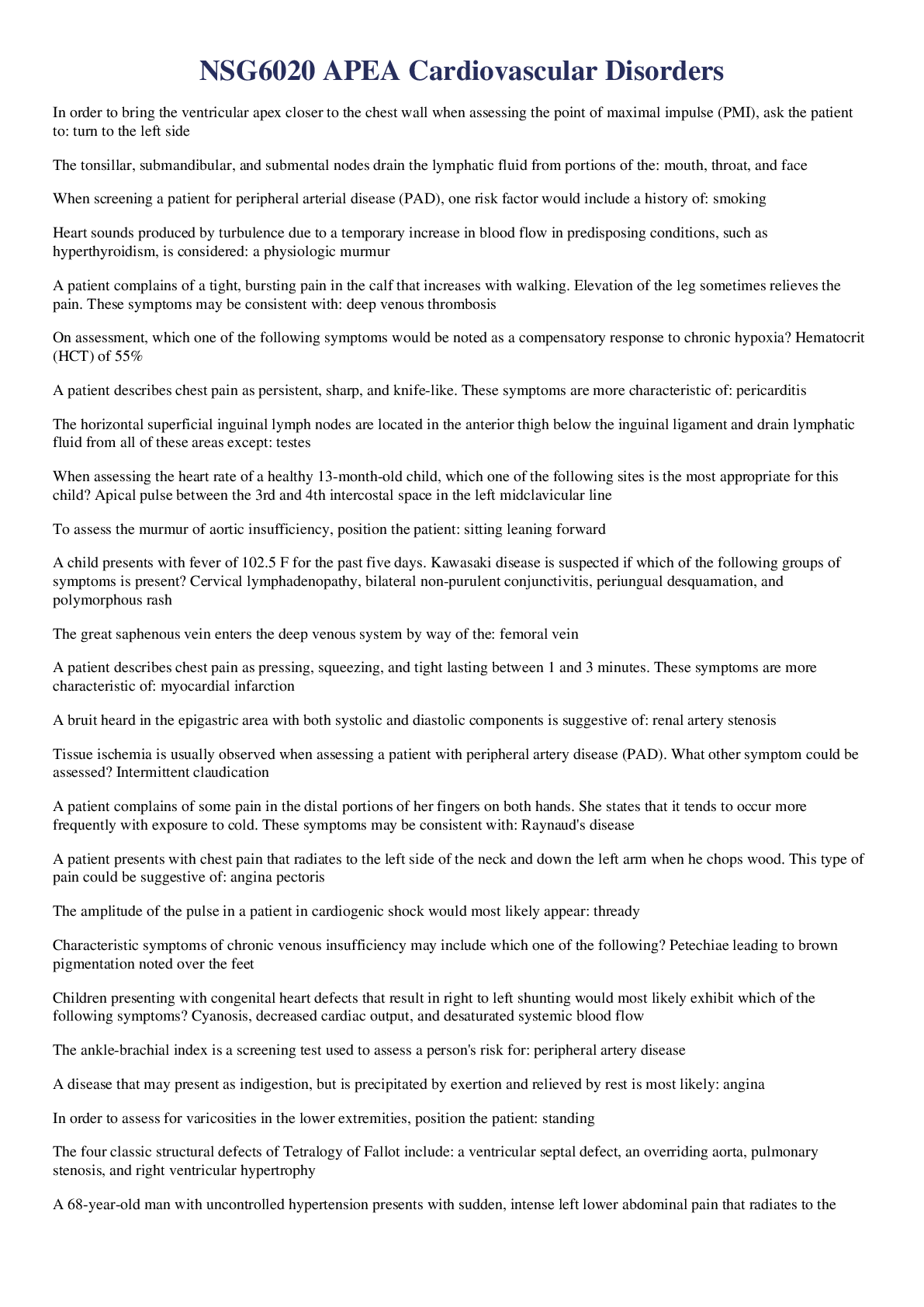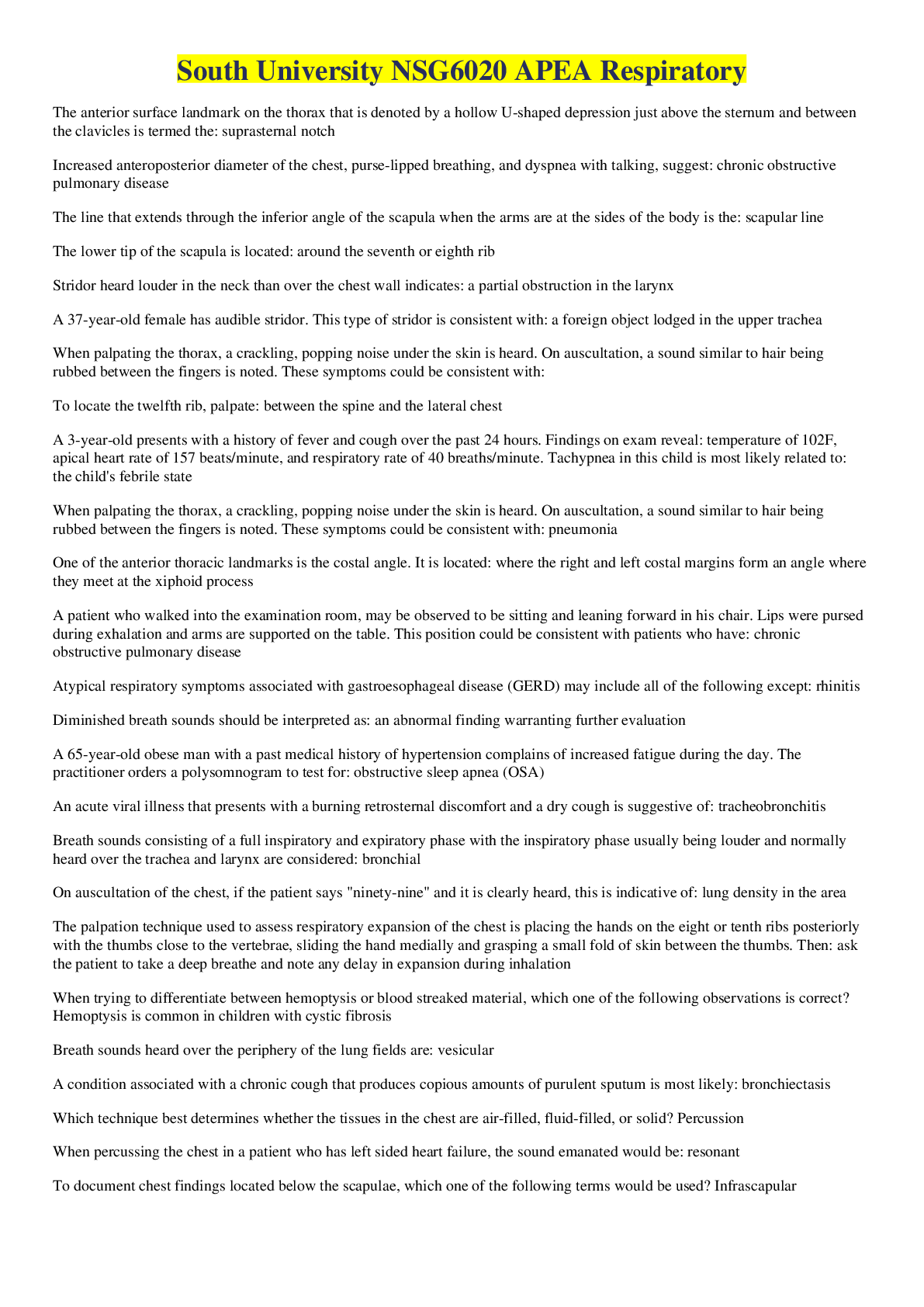*NURSING > EXAM > NURSING 1950 Mental Health Module 4 Exam (GRADED A) Questions and Answers Solutions/ Download To Sco (All)
NURSING 1950 Mental Health Module 4 Exam (GRADED A) Questions and Answers Solutions/ Download To Score A
Document Content and Description Below
NURSING 1950 Mental Health Module 4 Exam (GRADED A) Questions and Answers Solutions A patient diagnosed with alcoholism asks, "How will Alcoholics Anonymous (AA) help me?" Select the nurse's best r... esponse. "An individual is supported by peers while striving for abstinence one day at a time." 1. A nurse reviews vital signs for a patient admitted with an injury sustained while intoxicated. The medical record shows these blood pressure and pulse readings at the times listed: 0200: 118/78 mm Hg and 72 beats/min 0400: 126/80 mm Hg and 76 beats/min 0600: 128/82 mm Hg and 72 beats/min 0800: 132/88 mm Hg and 80 beats/min 1000: 148/94 mm Hg and 96 beats/min What is the nurse's priority action? Consult the health care provider 2. A nurse cares for a patient diagnosed with an opioid overdose. Which focused assessment has the highest priority? Respiratory 3. A patient admitted for injuries sustained while intoxicated has been hospitalized for 48 hours. The patient is now shaky, irritable, anxious, diaphoretic, and reports nightmares. The pulse rate is 130 beats/min. The patient shouts, "Bugs are crawling on my bed. I've got to get out of here." Select the most accurate assessment of this situation. The patient: has symptoms of alcohol-withdrawal delirium 4. A patient admitted yesterday for injuries sustained while intoxicated believes bugs are crawling on the bed. The patient is anxious, agitated, and diaphoretic. What is the priority nursing diagnosis? Risk for injury 5. A hospitalized patient diagnosed with an alcohol abuse disorder believes the window blinds are snakes trying to get in the room. The patient is anxious, agitated, and diaphoretic. The nurse can anticipate the health care provider will prescribe a(n): sedative, such as lorazepam (Ativan) or chlordiazepoxide (Librium) 6. A hospitalized patient diagnosed with an alcohol abuse disorder believes spiders are spinning entrapping webs in the room. The patient is fearful, agitated, and diaphoretic. Which nursing intervention is indicated? One-on-one supervision 7. A patient diagnosed with an alcohol abuse disorder says, "Drinking helps me cope with being a single parent." Which therapeutic response by the nurse would help the patient conceptualize the drinking objectively? "Tell me what happened the last time you drank." 8. A patient asks for information about Alcoholics Anonymous. Select the nurse's best response. "Alcoholics Anonymous is a: “self-help group for which the goal is sobriety." 9. Police bring a patient to the emergency department after an automobile accident. The patient demonstrates ataxia and slurred speech. The blood alcohol level is 500 mg%. Considering the relationship between the behavior and blood alcohol level, which conclusion is most probable? The patient: has a high tolerance to alcohol 10. A patient admitted to an alcoholism rehabilitation program tells the nurse, "I'm actually just a social drinker. I usually have a drink at lunch, two in the afternoon, wine with dinner, and a few drinks during the evening." The patient is using which defense mechanism? Denial 11. Which medication to maintain abstinence would most likely be prescribed for patients with an addiction to either alcohol or opioids? Naltrexone (ReVia) 12. During the third week of treatment, the spouse of a patient in a rehabilitation program for substance abuse says, "After this treatment program, I think everything will be all right." Which remark by the nurse will be most helpful to the spouse? "While sobriety solves some problems, new ones may emerge as one adjusts to living without drugs and alcohol." 13. The treatment team discusses the plan of care for a patient diagnosed with schizophrenia and daily cannabis abuse who is having increased hallucinations and delusions. To plan effective treatment, the team should: consider each diagnosis primary and provide simultaneous treatment 14. Select the most therapeutic manner for a nurse working with a patient beginning treatment for alcohol addiction. Empathetic, supportive 15. Which features should be present in a therapeutic milieu for a patient with a hallucinogen overdose? Simple and safe 16. When a patient first began using alcohol, two drinks produced relaxation and drowsiness. After 1 year, four drinks are needed to achieve the same response. Why has this change occurred? Tolerance has developed 17. At a meeting for family members of alcoholics, a spouse says, "I did everything I could to help. I even requested sick leave when my partner was too drunk to go to work." The nurse assesses these comments as: codependence 18. In the emergency department, a patient's vital signs are BP 66/40 mm Hg; pulse 140 beats/min; respirations 8 breaths/min and shallow. The nursing diagnosis is Ineffective breathing pattern related to depression of respiratory center secondary to narcotic intoxication. Select the priority outcome. Within 4 hours, vital signs will stabilize, with BP above 90/60 mm Hg, pulse less than 100 beats/min, and respirations at or above 12 breaths/min 19. Family members of an individual undergoing a residential alcohol rehabilitation program ask, "How can we help?" Select the nurse's best response. "Make your loved one responsible for the consequences of behavior." 20. Which goal for treatment of alcoholism should the nurse address first? Achieve physiologic stability 21. A patient with an antisocial personality disorder was treated several times for substance abuse, but each time the patient relapsed. Which treatment approach is most appropriate? Residential program 22. Select the priority nursing intervention when caring for a patient after an overdose of amphetamines. Monitor vital signs 23. Symptoms of withdrawal from opioids for which the nurse should assess include: nausea, vomiting, diaphoresis, anxiety, and hyperreflexia 24. A patient has smoked two packs of cigarettes daily for many years. When the patient tries to reduce smoking, anxiety, craving, poor concentration, and headache occur. This scenario describes: substance addiction 25. Which assessment findings are likely for an individual who recently injected heroin? Drowsiness, constricted pupils, slurred speech 26. An adult in the emergency department states, "Everything I see appears to be waving. I am outside my body looking at myself. I think I'm losing my mind." Vital signs are slightly elevated. The nurse should suspect: hallucinogen ingestion 27. A nurse wants to research epidemiology, assessment techniques, and best practices regarding persons with addictions. Which resource will provide the most comprehensive information? Substance Abuse and Mental Health Services Administration (SAMHSA) 28. A patient is thin, tense, jittery, and has dilated pupils. The patient says, "My heart is pounding in my chest. I need help." The patient allows vital signs to be taken but then becomes suspicious and says, "You could be trying to kill me." The patient refuses further examination. Abuse of which substance is most likely? Amphetamines 29. Select the priority outcome for a patient completing the fourth alcohol- detoxification program in the past year. Prior to discharge, the patient will: state, "I know I need long-term treatment." 30. A nurse prepares for an initial interaction with a patient with a long history of methamphetamine abuse. Which is the nurse's best first action? Self-assess personal attitude, values, and beliefs about this health problem 31. A patient undergoing alcohol rehabilitation decides to begin disulfiram (Antabuse) therapy. Patient teaching should include the need to: (select all that apply) -avoid alcohol-based skin products -read labels of all liquid medications -avoid breathing fumes of paints, stains, and stripping compounds 32. The nurse can assist a patient to prevent substance abuse relapse by: (select all that apply) - rehearsing techniques to handle anticipated stressful situations - assisting the patient to identify life skills needed for effective coping - informing the patient of physical changes to expect as the body adapts to functioning without substances 33. A patient took a large quantity of bath salts. Priority nursing and medical measures include: (select all that apply) - management of heart rate - environmental safety 34. A new patient beginning an alcoholism rehabilitation program says, "I'm just a social drinker. I usually have one drink at lunch, two in the afternoon, wine at dinner, and a few drinks during the evening." Select the nurse's most therapeutic responses. Select all that apply. -"Social drinkers have one or two drinks, once or twice a week." -"You describe drinking steadily throughout the day and evening." 35. Which of the following statements most accurately describes the concept of tolerance? A person needs increasing amounts of a substance to achieve a desired effect 36. Which of the following medications is frequently used to detoxify a client in alcohol withdrawal? Diazepam (Valium) 37. Detoxification protocols have been developed and implemented for all of the following substances, except cannabinoids 38. Which of the following complications of substance abuse is considered life threatening? Delirium tremens 39. A syndrome that occurs after stopping use of a drug is withdrawal 40. The only class of commonly abused drugs that has a specific antidote is opiates 41. The term tolerance, as it relates to substance abuse, refers to the need to take larger amounts of a substance to achieve the same effects 42. Benzodiazepines are useful for treating alcohol withdrawal because they bind to ã-aminobutyric acid-benzodiazepine receptors 43. A person who covertly supports the substance-abusing behavior of another is called a(n) enabler 44. A client who is dependent on alcohol and drinks several six-packs of beer daily tells the nurse "Alcohol is no problem to me. I can quit anytime I want to." The nurse can assess this statement as indicating denial 45. What is the ethical obligation of the nurse who has seen a peer divert a narcotic compared with the ethical obligation when the nurse observes a peer to be under the influence of alcohol? Supervisory staff should be informed as soon as possible in both cases 46. Which drug is most apt to have been ingested by a young woman who comes to the emergency department with the report that although she has no recollection of the incident, she believes she was sexually assaulted at a party? GHB 47. While helping an addicted individual plan for ongoing treatment, which of the following interventions is the first priority for a safe recovery? The client strives to maintain abstinence 48. Symptoms that would signal opioid withdrawal include lacrimation, rhinorrhea, dilated pupils, and muscle aches 49. Which of the drugs used by a polysubstance abuser is most likely to be responsible for withdrawal symptoms requiring both medical intervention and nursing support? Barbiturates 50. Nursing assessment of an alcohol-dependent client 6 to 12 hours after the last drink would most likely reveal the presence of tremors 51. A client has been using cocaine intranasally for 4 years. Two months ago she started freebasing. For the past week she has locked herself in her apartment and has used $8000 worth of cocaine. When brought to the hospital she was unconscious. Nursing measures should include observation for hyperpyrexia and seizures 52. An unconscious client is admitted to the emergency department. The admitting diagnosis is "rule out opiate overdose." Which item of assessment data would be most consistent with opiate overdose? Blood pressure, 80/40 mm Hg; pulse, 120 beats/min; respirations, 10 breaths/min 53. Cocaine exerts which of the following effects on a client? Stimulation and anesthetic effects 54. An appropriate long-term goal/outcome for a recovering substance abuser would be that the client will abstain from the use of mood-altering substances 55. A client was in an automobile accident. Although he has the odor of alcohol on his breath, his speech is clear and he is alert and answers questions posed to him. The law enforcement officer requests that the emergency department staff draw a blood sample for blood alcohol level determination. The level is determined to be 0.30 mg%. What conclusion can be drawn? The client has a high tolerance to alcohol 56. A client brought to the emergency department at the university hospital after PCP ingestion tries to run up and down the hallway. The nursing intervention that would be most therapeutic is obtaining an order for seclusion and close observation 57. A teaching need is revealed when a client taking disulfiram states "Most over-the-counter cough syrups are OK for me to use." 58. The most helpful message to transmit about relapse to the recovering alcoholic client is that lapses result from lack of good situational support 59. All of the following substances are considered central nervous system stimulants, except methadone 60. An adult outpatient diagnosed with major depression has a history of several suicide attempts by overdose. Given this patient's history and diagnosis, which antidepressant medication would the nurse expect to be prescribed? Fluoxetine (Prozac), a selective serotonin reuptake inhibitor 61. Four individuals have given information about their suicide plans. Which plan evidences the highest suicide risk? Jumping from a railroad bridge located in a deserted area late at night 62. Which measure would be considered a form of primary prevention for suicide? Helping school children learn to manage stress and be resilient 63. Which change in the brain's biochemical function is most associated with suicidal behavior? Serotonin deficiency 64. A college student who failed two tests cried for hours and then tried to telephone a parent but got no answer. The student then gave several expensive sweaters to a roommate and asked to be left alone for a few hours. Which behavior provides the strongest clue of an impending suicide attempt? Giving away sweaters 65. A nurse uses the SAD PERSONS scale to interview a patient. This tool provides data relevant to: suicide potential 66. A person intentionally overdosed on antidepressants. Which nursing diagnosis has the highest priority? Risk for suicide 67. A person who attempted suicide by overdose was treated in the emergency department and then hospitalized. The initial outcome is that the patient will: exercise suicide self-restraint by refraining from attempts to harm self for 24 hours 68. A college student who attempted suicide by overdose was hospitalized. When the parents were contacted, they responded, "We should have seen this coming. We did not do enough." The parents' reaction reflects: guilt 69. Select the most critical question for the nurse to ask an adolescent who has threatened to take an overdose of pills. "Do you have access to medications?" 70. It has been 5 days since a suicidal patient was hospitalized and prescribed an antidepressant medication. The patient is now more talkative and shows increased energy. Select the highest priority nursing intervention. Supervise the patient 24 hours a day 71. A nurse and patient construct a no-suicide contract. Select the preferable wording. "For the next 24 hours, I will not in any way attempt to harm or kill myself." 72. A tearful, anxious patient at the outpatient clinic reports, "I should be dead." The initial task of the nurse conducting the assessment interview is to: establish rapport with the patient 73. A nurse interacts with an outpatient who has a history of multiple suicide attempts. Select the most helpful response for a nurse to make when the patient states, "I am considering committing suicide." "Bringing up these feelings is a very positive action on your part." 74. Which intervention will the nurse recommend for the distressed family and friends of someone who has committed suicide? Attending a self-help group for survivors 75. Which statement provides the best rationale for closely monitoring a severely depressed patient during antidepressant medication therapy? As depression lifts, physical energy becomes available to carry out suicide 76. A nurse assesses a patient who reports a 3-week history of depression and periods of uncontrolled crying. The patient says, "My business is bankrupt, and I was served with divorce papers." Which subsequent statement by the patient alerts the nurse to a concealed suicidal message? "I have a plan that will fix everything." 77. A depressed patient says, "Nothing matters anymore." What is the most appropriate response by the nurse? "Are you having thoughts of suicide?" 78. A nurse counsels a patient with recent suicidal ideation. Which is the nurse's most therapeutic comment? "Let's consider which problems are very important and which are less important." 79. When assessing a patient's plan for suicide, what aspect has priority? Availability of means and lethality of method 80. The feeling experienced by a patient that should be assessed by the nurse as most predictive of elevated suicide risk is hopelessness 81. Which statement by a depressed patient will alert the nurse to the patient's need for immediate, active intervention? "I have no one to turn to for help or support." 82. A patient hospitalized for 2 weeks committed suicide during the night. Which initial nursing measure will be most important regarding this event? Hold a staff meeting to express feelings and plan care for the other patients 83. After one of their identical twin daughters commits suicide, the parents express concern that the other twin may also have suicidal tendencies. Which reply should the nurse provide? "Genetics are associated with suicide risk. Monitoring and support are important." 84. Which individual in the emergency department should be considered at highest risk for completing suicide? A 79-year-old single, white male diagnosed recently with terminal cancer of the prostate 85. A nurse assesses five newly hospitalized patients. Which patients have the highest suicide risk? Select all that apply. -82-year-old white male -17-year-old white female -19-year-old Native American male 86. Which nursing interventions will be implemented for a patient who is actively suicidal? Select all that apply. -Maintain arm's-length, one-on-one direct observation at all times -Check all items brought by visitors and remove risk items -Use plastic eating utensils; count utensils upon collection 87. A college student is extremely upset after failing two examinations. The student said, "No one understands how this will hurt my chances of getting into medical school." The student then suspends access to his social networking website and turns off his cell phone. Which suicide risk factors are evident? Select all that apply. -Shame -Humiliation -Self-imposed isolation -Recent stressful life event 88. A patient comes to the crisis clinic after an unexpected job termination. The patient paces around the room sobbing, cringes when approached, and responds to questions with only shrugs or monosyllables. Choose the nurse's best initial comment to this patient. "I see you are feeling upset. I'm going to stay and talk with you to help you feel better." 89. A patient being seen in the clinic for superficial cuts on both wrists is pacing and sobbing. After a few minutes, the patient is calmer. The nurse attempts to determine the patient's perception of the precipitating event by asking: "What was happening just before you started to feel this way?" 90. A patient comes to the crisis center saying, "I'm in a terrible situation. I don't know what to do." The triage nurse can initially assume that the patient is: anxious and fearful 91. An adolescent comes to the crisis clinic and reports sexual abuse by an uncle. The adolescent told both parents about the uncle's behavior, but the parents did not believe the adolescent. What type of crisis exists? Adventitious 92. While conducting the initial interview with a patient in crisis, the nurse should: speak in short, concise sentences 93. An adult seeks counseling after the spouse was murdered. The adult angrily says, "I hate the beast that did this. It has ruined my life. During the trial, I don't know what I'll do if the jury doesn't return a guilty verdict." What is the nurse's highest priority response? "Are you having thoughts of hurting yourself or others?" 94. Six months ago, a woman had a prophylactic double mastectomy because of a family history of breast cancer. One week ago, this woman learned her husband was involved in an extramarital affair. The woman tearfully says to the nurse, "What else can happen?" What type of crisis is this person experiencing? Situational 95. A woman said, "I can't take anymore! Last year my husband had an affair, and now we don't communicate. Three months ago, I found a lump in my breast. Yesterday my daughter said she's quitting college." What is the nurse's priority assessment? Clarify what the patient means by "I can't take anymore." 96. Six months ago, a woman had a prophylactic double mastectomy because of a family history of breast cancer. One week ago, this woman learned her husband was involved in an extramarital affair. The woman tearfully, "What else can happen?" If the woman's immediate family is unable to provide sufficient support, the nurse should: ask what other relatives or friends are available for support 97. A woman says, "I can't take anymore. Last year my husband had an affair, and now we do not communicate. Three months ago, I found a lump in my breast. Yesterday my daughter said she's quitting college and moving in with her boyfriend." Which issue should the nurse focus on during crisis intervention? Coping with the reaction to the daughter's events 98. A patient who is visiting the crisis clinic for the first time asks, "How long will I be coming here?" The nurse's reply should consider that the usual duration of crisis intervention is: 4 to 8 weeks 99. A student falsely accused a college professor of sexual intimidation. The professor tells the nurse, "I cannot teach nor do any research. My mind is totally preoccupied with these false accusations." What is the priority nursing diagnosis? Ineffective role performance related to distress from false accusations 100. Which communication technique will the nurse use more in crisis intervention than traditional counseling? Giving direction 101. Which situation demonstrates use of primary care related to crisis intervention? Teaching stress reduction techniques to a first-year college student 102. A victim of spousal violence comes to the crisis center seeking help. Crisis intervention strategies the nurse uses will focus on: supporting emotional security and reestablishing equilibrium 103. After celebrating the fortieth birthday, an individual becomes concerned with the loss of youthful appearance. What type of crisis has occurred? Maturational 104. Which scenario is an example of an adventitious crisis? A riot at a rock concert 105. Which agency provides coordination in the event of a terrorist attack? National Incident Management System (NIMS) 106. During the initial interview at the crisis center, a patient says, "I've been served with divorce papers. I'm so upset and anxious that I can't think clearly." Which comment should the nurse use to assess personal coping skills? "In the past, how have you handled difficult or stressful situations?" 107. An adult has cared for a debilitated parent for 10 years. The parent's condition recently declined, and the health care provider recommended placement in a skilled nursing facility. The adult says, "I've always been able to care for my parents. Nursing home placement goes against everything I believe." Successful resolution of this person's crisis will most closely relate to: resolving the feelings associated with the threat to the person's self- concept 108. The principle most useful to a nurse planning crisis intervention for any patient is that the patient: is experiencing a state of disequilibrium 109. A nurse assesses a patient in crisis. Select the most appropriate question for the nurse to ask to assess this patient's situational support. "Who can be helpful to you during this time?" 110. An adult comes to the crisis clinic after termination from a job of 15 years. The patient says, "I don't know what to do. How can I get another job? Who will pay the bills? How will I feed my family?" Which nursing diagnosis applies? Powerlessness 111. A troubled adolescent pulled out a gun in a school cafeteria, fatally shooting three people and injuring many others. Hundreds of parents come to the school after hearing news reports. After police arrest the shooter, which action should occur next? Designate zones according to the alphabet and direct students to the zones based on their surnames to facilitate reuniting them with their parents 112. At the last contracted visit in the crisis intervention clinic, an adult says, "I've emerged from this a stronger person. You helped me get my life back in balance." The nurse responds, "I think we should have two more sessions to explore why your reactions were so intense." Which analysis applies? The nurse is having difficulty terminating the relationship 113. Which health care worker should be referred for critical incident stress debriefing? An emergency medical technician (EMT) who treated victims of a car bombing at a mall 114. A nurse driving home after work comes upon a serious automobile accident. The driver gets out of the car with no apparent physical injuries. Which assessment findings would the nurse expect from the driver immediately after this event? Select all that apply. - Difficulty using a cell phone - Rapid speech - Trembling 115. A team of nurses report to the community after a category 5 hurricane devastates many homes and businesses. The nurses provide emergency supplies of insulin to persons with diabetes and help transfer patients in skilled nursing facilities to sites that have electrical power. Which aspects of disaster management have these nurses fulfilled? Select all that apply. -Mitigation -Response 116. Emergency response workers arrive in a community after a large-scale natural disaster. What is the workers' first action? Report to the incident command system (ICS) center. 117. Anger can best be defined as a normal response to a perceived threat 118. The factor most likely to contribute to a client's escalating anger is a staff member telling him that he is inappropriate 119. Which assessment finding is the best predictor of violence in a newly admitted client? A recent assault on a drinking companion 120. Which nursing diagnosis is the priority when planning care for a client who displays considerable anger and occasional aggression? Risk for other-directed violence 121. Which neurotransmitter imbalance has been shown to be related to impulsive aggression? Low levels of serotonin 122. When working with an angry client, it is best to help the client reframe the anger-producing situation 123. Nurses coping with angry clients may find it helpful to remember that anger and aggression begin as feelings of vulnerability 124. Which would be the most appropriate response by the nurse to help a client who is demonstrating escalating anger? Walk the client to his room and help him practice stress-reduction techniques, such as deep breathing or muscle relaxation 125. The more a nurse's intervention is prompted by emotion the less likely it is to be therapeutic 126. The most restrictive method for dealing with an aggressive client who is out of control is seclusion 127. The client at highest risk for violence directed at others is one who has delusions of persecution 128. A client experiencing manic hyperactivity stands up, glares challengingly at clients and staff, and shouts, "This food is garbage! I'll fight anyone who says it's not!" The nurse's most relevant assessment is that the client has a high potential for other-directed violence 129. Which intervention strategy should be avoided by staff working with a client who is shouting and flailing his arms? Diffusing the situation by laughing or making a joke of the challenge 130. An adolescent male is swearing and shouting at his physician, who refused to give him a pass to leave the unit. This behavior is a major indicator that the client may become physically aggressive 131. A client waiting to see the physician is pacing and looking both angry and tense. When it's determined that the client won't be seen for another 30 minutes, the nurse addresses the client's agitation by explaining to the client what caused the backup and suggesting that he has time to go to the coffee shop 132. An angry client frequently loses patience with the nurses and shouts at them while they perform a complicated dressing change. Which plan could they create to intervene effectively in this behavior? When the client begins to become abusive, leave the room promising to return in 20 minutes when he has regained control 133. A nurse attempts to intervene verbally when an angry client initially threatens to throw a chair but quickly focuses the anger toward the nurse. Several staff members gather behind the nurse, but then the client shouts, "I will calm down when that nurse isn't in my face." The nurse best demonstrates the ability to help the client deescalate by moving to the rear of the staff group 134. A client has a history of demonstrating aggression physically. An appropriate short-term goal to help the client manage this anger is to identify situations that precipitate hostility 135. When a client diagnosed with a cognitive deficit experiences a catastrophic reaction, the priority intervention is to smile and call the client by name 136. A client has been placed in seclusion to control aggressive behavior. Care while the client is secluded should include providing for nutrition and hydration 137. Peter, a 21-year-old patient, asks you, "What's wrong with my brain that I have such a problem with aggression?" Your response is based on the knowledge that: the limbic system, the prefrontal cortex, and neurotransmitters have been implicated in playing a part in aggression 138. One older concept that is being used currently that may help in violence reduction in patients is: trauma-informed care 139. You are working in the emergency department. You notice Matt, your patient's husband, pacing in the hallway, muttering to himself, and looking angrily around the emergency department. Which of the following statements to Matt may help prevent escalation and/or violence? "You appear upset. Can I help you with anything?" 140. You are working on an adolescent psychiatric unit. Katy, aged 16 years, has been angry all day because her boyfriend was not allowed to visit last night. Katy is in the hallway and begins yelling, "It's not fair! You all hate me! I hate this place!" She begins pounding her fists on the wall. To deal with the situation and prevent further escalation, your best response would be to say: "Katy, I will help you calm down. Do you want to go to your room and talk or go to the quiet room?" 141. When you approach Katy, what considerations should you take? Have other staff as backup, and stand far enough away to avoid injury 142. An elderly patient is being cared for in a nursing home. The patient shouts that she wants to go home as her children are waiting for her. The patient says the children are very young and need to be fed. What is the most appropriate response by the nurse? "You miss your children. Can you tell me something more about them?" 143. The nurse receives a patient with an injury and provides first aid to the patient. Another patient who had been present in the treatment room suddenly becomes aggressive and shouts at the nurse. The patient threatens the nurse with a pair of scissors to get the nurse to attend to them first. What should be the most appropriate response of the nurse? "Would you please tell me your problem?" 144. A patient has been placed in seclusion to control aggressive behavior. Care while the patient is secluded should include Providing for nutrition and hydration 145. The nurse is assigned to care for an aggressive patient who is holding a sharp object. What nursing action is most appropriate for this patient? Making firm eye contact with the patient while speaking 146. The parent of a hospitalized adolescent enters the inpatient unit yelling, "What is wrong with you people? My daughter cut herself and you let it to happen. I thought my child would be safe here." Select the nurse's appropriate response. "I can't understand you when your voice is so loud. Let's go to a private area and talk about it." 147. Which comment by the nurse would best support relationship building with a survivor of intimate partner abuse? "You are feeling violated because you thought you could trust your partner." 148. An 11-year-old reluctantly tells the nurse, "My parents don't like me. They said they wish I was never born." Which type of abuse is likely? Emotional 149. What feelings are most commonly experienced by nurses working with abusive families? Helplessness regarding the victim and anger toward the abuser 150. Which rationale best explains why a nurse should be aware of personal feelings while working with a family experiencing family violence? Strong negative feelings interfere with assessment and judgment 151. The parents of a 15-year-old seek to have this teen declared a delinquent because of excessive drinking, habitually running away, and prostitution. The nurse interviewing the patient should recognize these behaviors often occur in adolescents who: have been abused 152. What is a nurse's legal responsibility if child abuse or neglect is suspected? Report the suspicion according to state regulations 153. Several children are seen in the emergency department for treatment of various illnesses and injuries. Which assessment finding would create the most suspicion for child abuse? The child who has: bruises on extremities 154. An 11-year-old says, "My parents don't like me. They call me stupid and say they wish I were never born. It doesn't matter what they think because I already know I'm dumb." Which nursing diagnosis applies to this child? Chronic low self-esteem related to negative feedback from parents 155. An adult has recently been absent from work for 3-day periods on several occasions. Each time, the individual returned wearing dark glasses. Facial and body bruises were apparent. What is occupational health nurse's priority assessment? Physical injuries 156. A young adult has recently had multiple absences from work. After each absence, this adult returned to work wearing dark glasses and long-sleeved shirts. During an interview with the occupational health nurse, this adult says, "My partner beat me, but it was because I did not do the laundry." What is the nurse's next action? Document injuries with a body map 157. A patient tells the nurse, "My husband lost his job. He's abusive only when he drinks too much. His family was like that when he was growing up. He always apologizes and regrets hurting me." What risk factor was most predictive for the husband to become abusive? History of family violence 158. An adult tells the nurse, "My partner abuses me when I make mistakes, but I always get an apology and a gift afterward. I've considered leaving but haven't been able to bring myself to actually do it." Which phase in the cycle of violence prevents this adult from leaving? Honeymoon 159. After treatment for a detached retina, a survivor of intimate partner abuse says, "My partner only abuses me when I make mistakes. I've considered leaving, but I was brought up to believe you stay together, no matter what happens." Which diagnosis should be the focus of the nurse's initial actions? Risk for injury related to physical abuse from partner 160. A survivor of physical spousal abuse was treated in the emergency department for a broken wrist. This patient said, "I've considered leaving, but I made a vow and I must keep it no matter what happens." Which outcome should be met before discharge? The patient will: name two community resources for help 161. An older adult with Lewy body dementia lives with family and attends a day care center. A nurse at the day care center noticed the adult had a disheveled appearance, strong odor of urine, and bruises on the limbs and back. What type of abuse might be occurring? Physical 162. An older adult with Alzheimer's disease lives with family in a rural area. During the week, the person attends a day care center while the family is at work. In the evenings, members of the family provide care. Which factor makes this patient most vulnerable to abuse? Alzheimer's disease 163. An older adult with Lewy body dementia lives with family. After observing multiple bruises, the home health nurse talked with the daughter, who became defensive and said, "My mother often wanders at night. Last night she fell down the stairs." Which nursing diagnosis has priority? Risk for injury related to poor judgment, cognitive impairments, and inadequate supervision 164. An older woman diagnosed with Alzheimer's disease lives with family and attends day care. After observing poor hygiene, the nurse talked with the caregiver. This caregiver became defensive and said, "It takes all my energy to care for my mother. She's awake all night. I never get any sleep." Which nursing intervention has priority? Secure additional resources for the mother's evening and night care 165. An adult has a history of physical violence against family when frustrated, followed by periods of remorse after each outburst. Which finding indicates a successful plan of care? The adult: expresses frustration verbally instead of physically 166. Which referral will be most helpful for a woman who was severely beaten by intimate partner, has no relatives or friends in the community, is afraid to return home, and has limited financial resources? A women's shelter 167. A 10-year-old cares for siblings while the parents work because the family cannot afford a babysitter. This child says, "My father doesn't like me. He calls me stupid all the time." The mother says the father is easily frustrated and has trouble disciplining the children. The community health nurse should consider which resources as priorities to stabilize the home situation? Select all that apply. -Parental sessions to teach childrearing practices -Anger management counseling for the father -Continuing home visits to give support 168. A nurse assists a victim of intimate partner abuse to create a plan for escape if it becomes necessary. Which components should the plan include? Select all that apply. Keep a cell phone fully charged. Have the phone number for the nearest shelter. Secure a supply of current medications for self and children. Assemble birth certificates, Social Security cards, and licenses. Determine a code word to signal children when it is time to leave. 169. A community health nurse visits a family with four children. The father behaves angrily, finds fault with the oldest child, and asks twice, "Why are you such a stupid kid?" The wife says, "I have difficulty disciplining the children. It's so frustrating." Which comments by the nurse will facilitate an interview with these parents? Select all that apply. "Tell me how you discipline your children." "How do you stop your baby from crying?" "Caring for four small children must be difficult." 170. The nurse at a university health center leads a dialogue with female freshmen about rape and sexual assault. One student says, "If I avoid strangers or situations where I am alone outside at night, I'll be safe from sexual attacks." Choose the nurse's best response. "Sexual assaults are more often perpetrated by acquaintances. Let's discuss ways to prevent that." 171. A woman was found confused and disoriented after being abducted and raped at gunpoint by an unknown assailant. The emergency department nurse makes these observations about the woman: talking rapidly in disjointed phrases, unable to concentrate, indecisive when asked to make simple decisions. What is the woman's level of anxiety? Severe 172. After an abduction and rape at gunpoint by an unknown assailant, which assessment finding best indicates that a patient is in the acute phase of the rape- trauma syndrome? Confusion and disbelief 173. A nurse interviews a patient abducted and raped at gunpoint by an unknown assailant. The patient says, "I can't talk about it. Nothing happened. I have to forget." What is the patient's present coping strategy? Denial 174. An emergency department nurse prepares to assist with evidence collection for a sexual assault victim. Prior to photographs and pelvic examination, what documentation is important? Consent signed by the patient 175. A nurse in the emergency department assesses an unresponsive victim of rape. The victim's friend reports, "That guy gave her salty water before he raped her." Which question is most important for the nurse to ask of the victim's friend? "Has the victim consumed any alcohol?" 176. A rape victim says to the nurse, "I always try to be so careful. I know I should not have walked to my car alone. Was this attack my fault?" Which communication by the nurse is most therapeutic? Support the victim to separate issues of vulnerability from blame 177. A rape victim tells the nurse, "I should not have been out on the street alone." Select the nurse's most therapeutic response. "You feel as though this would not have happened if you had not been alone." 178. The nursing diagnosis Rape-trauma syndrome applies to a rape victim in the emergency department. Select the most appropriate outcome to achieve before discharging the patient. The patient agrees to a follow-up appointment with a rape victim advocate 179. A rape victim visited a rape crisis counselor weekly for 8 weeks. At the end of this counseling period, which comment by the victim best demonstrates that reorganization was successful? "I'm sleeping better although I still have an occasional nightmare." 180. A nurse interviews a 17-year-old male victim of sexual assault. The victim is reluctant to talk about the experience. Which comment should the nurse offer to this victim? "Male victims of sexual assault often experience physical injuries and are assaulted by more than one person." 181. A nurse works a rape telephone hotline. Communication with potential victims should focus on: explaining immediate steps victims should take 182. A nurse cares for a rape victim who was given a drink that contained flunitrazepam (Rohypnol) by an assailant. Which intervention has priority? Monitoring for: respiratory depression 183. Which situation describes consensual sex rather than rape? A woman's lover pleads with her to have oral sex. She gives in but later regrets the decision 184. Before a victim of sexual assault is discharged from the emergency department, the nurse should: provide referral information verbally and in writing 185. A victim of a sexual assault who sits in the emergency department is rocking back and forth and repeatedly saying, "I can't believe I've been raped." This behavior is characteristic of which stage of rape-trauma syndrome? The acute phase reaction 186. A victim of a sexual assault comes to the hospital for treatment but abruptly decides to decline treatment and leaves the facility. While respecting the person's rights, the nurse should: provide written information about physical and emotional reactions the person may experience 187. An unconscious teenager is treated in the emergency department. The teenager's friends suspect a rape occurred at a party. Priority action by the nurse should focus on: maintaining physiologic stability 188. A victim of a violent rape was treated in the emergency department. As discharge preparation begins, the victim says softly, "I will never be the same again. I can't face my friends. There is no reason to go on." Select the nurse's most appropriate response. "Are you thinking of harming yourself?" 189. When an emergency department nurse teaches a victim of rape-trauma syndrome about reactions that may occur during the long-term phase of reorganization, which symptoms should be included? Select all that apply. -Development of fears and phobias -Feelings of numbness -Flashbacks, dreams 190. A patient was abducted and raped at gunpoint by an unknown assailant. Which nursing interventions are appropriate while caring for the patient in the emergency department? - Allow the patient to talk at a comfortable pace - Place the patient in a private room with a caregiver - Pose questions in nonjudgmental, empathetic ways 191. An emergency department nurse prepares to assist with examination of a sexual assault victim. What equipment will be needed to collect and document forensic evidence? - Camera - Body map - DNA swabs 192. Which aspects of assessment have priority when a nurse interviews a rape victim in an acute setting? Coping mechanisms the patient is using Signs and symptoms of emotional and physical trauma Adequacy and availability of the patient's support system 193. A rape victim tells the emergency nurse, "I feel so dirty. Help me take a shower before I get examined." The nurse should: -explain that bathing destroys evidence -offer the victim a shower after evidence is collected [Show More]
Last updated: 1 year ago
Preview 1 out of 27 pages
Instant download

Buy this document to get the full access instantly
Instant Download Access after purchase
Add to cartInstant download
Also available in bundle (1)

Nursing 1950 Mental Health Module BUNDLE Exams 1-6 with Questions and Answers- SRTC
Nursing 1950 Mental Health Module BUNDLE Exams 1-6 with Questions and Answers- SRTC
By A+ Solutions 2 years ago
$14.5
6
Reviews( 0 )
Document information
Connected school, study & course
About the document
Uploaded On
Jun 24, 2021
Number of pages
27
Written in
Additional information
This document has been written for:
Uploaded
Jun 24, 2021
Downloads
0
Views
63






.png)






